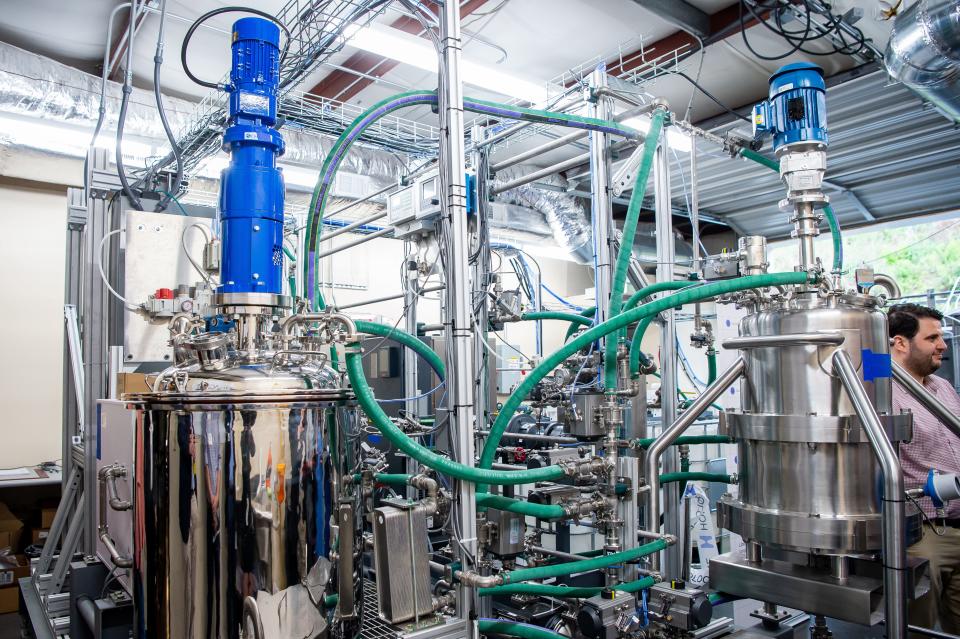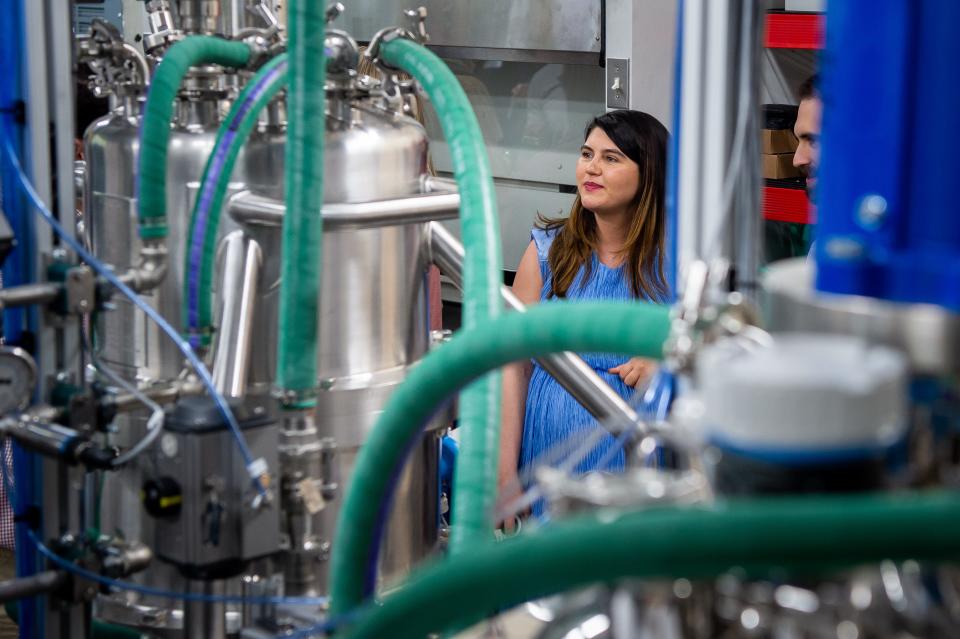A Knoxville machine is turning pollution on its head, inhaling CO2 instead of releasing it
- Oops!Something went wrong.Please try again later.
Imagine a machine the size of a coal plant that, instead of pumping carbon dioxide into the atmosphere, sucks the gas from the air and permanently stores it underground.
This machine of the future now exists in Knoxville, thanks to a startup called Holocene, whose mission is nothing less than to reverse the tide of climate change.
The company's small-scale pilot sucks in air, captures the carbon dioxide in liquid form, solidifies it and then turns it back into a gas that can be pumped underground.
Though it looks formidable now, the machine's predecessor was built in the living room of co-founder and CEO Anca Timofte using parts from Home Depot and Amazon.
In less than a year, Holocene went from lab experiments to a machine that can annually capture 10 tons of carbon dioxide. Timofte said the company needs to scale up operations by that much all over again.
"The world has reached consensus on climate change," she said. "We have to remove tens of billions of tons of CO2 in the next two and a half decades. This is an incredible, incredible challenge. It will require moving more mass and more material than the oil and gas industry has in 150 years."
In addition to offsetting carbon emissions from power plants and the transportation sector, the technology could be used to remove carbon left over from the past century and a half.
That's how Holocene got its name − from the Holocene Epoch, an ongoing geological time period marked by the impact of humans on Earth.
How Holocene's carbon tech turned from idea to reality
The idea for Holocene began in Timofte's dorm room while she was a business student at Stanford University. Prior to that, she was an engineer at Climeworks, a Swiss company that pioneered carbon capture technology.
On May 8, the same day Holocene cut the ribbon for its machine on Papermill Drive, Climeworks announced it had switched on the world's largest direct air capture machine in Iceland.
Holocene's technology is unique because it can operate continuously at low heat. It primarily uses heat as fuel, rather than electricity, and regenerates the amino acid used to capture carbon dioxide.

The machine has captured the attention of the Elon Musk Foundation, Bill Gates' Breakthrough Energy and the U.S. Department of Energy. Shopify and Klarna are among Holocene's customers who have purchased carbon credits to help accomplish their sustainability goals.
It's no accident Holocene built one of the world's few operating direct air capture systems in Knoxville. From early in the journey, Timofte worked closely with scientists at Oak Ridge National Laboratory. The lab licensed a chemical breakthrough to Holocene last year, letting them bring a lab discovery to the market.
Holocene is a participant of Innovation Crossroads, a competitive program that gives startups two years of funding and lab space to develop their technology. The office where its first pilot machine sits previously belonged to a startup with a similar mission, SkyNano.
Holocene has caught the attention of local investors, too.
"One of the things that stands out about Holocene is they didn't pick some easy problem to solve," said John Bruck, co-founder of Knoxville-based venture capital firm Market Square Ventures. "This is perhaps the single most important problem that we as a human community can try and solve in our lifetimes or our kids' lifetimes."
Holocene machine only the beginning, and TVA could benefit
Timofte created Holocene with Keeton Ross − a fellow MBA student at Stanford − and her Climeworks colleague Tobias Rüesch. The Holocene team now includes 15 employees.
The company's next machine will be much larger than what can fit in an office space, as it will need to be 250 to 500 times more powerful to begin delivering carbon capture credits customers have purchased.
One potential future customer is the Tennessee Valley Authority, which wants its system of power plants to reach net-zero carbon emissions by 2050. In the future, a Holocene machine could be stationed next to a TVA gas plant to capture emissions and could even be powered with heat from the plant that's normally wasted.

"We know that we're going to have to rely on technologies that are emerging, that are not yet available at commercial scale today, and we're out looking for those technologies," Amy Henry, TVA's director of transformational innovation, said at the Holocene ceremony.
For every million particles in the atmosphere, roughly 420 are carbon dioxide, a number that is only increasing. To meet global net zero goals, machines like Holocene's will need to capture one billion tons of carbon from the atmosphere annually by 2050, according to the International Energy Agency.
When Holocene switched on its machine for a demonstration, the air near the interstate had 450 parts per million of carbon. In a matter of seconds, that number was down to 90 parts per million, proof of Holocene's "transformative" potential, co-founder Keeton Ross said.
"The fact that we're here today, it was not a forgone conclusion," Ross said. "We should celebrate. It feels great, but there was a lot of super hard work that went into this."
Daniel Dassow is a growth and development reporter focused on technology and energy. Phone 423-637-0878. Email daniel.dassow@knoxnews.com.
Support strong local journalism by subscribing at knoxnews.com/subscribe.
This article originally appeared on Knoxville News Sentinel: Knoxville startup Holocene captures carbon with innovative CO2 machine

